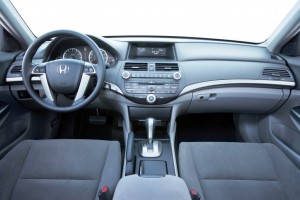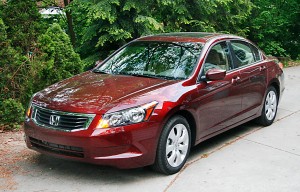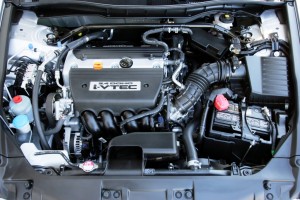The Honda versus Toyota question goes back for decades, not as long as the Yankees versus the Red Sox, but with almost the same intensity among fans as the ongoing diamond debate.
The latest version of the Accord, introduced in 2008, is more aggressively styled, has a larger interior and better driving dynamics than the long-time best seller in the class, the Toyota Camry. In short, the Accord, originally introduced in 1976 as a 3-door hatchback with a wheelbase of the current Honda Fit b-car has grown as its buyers aged.
The tradeoff for “more fun to drive” traits in the current car is that Accord is also little harsher and nosier than the “mostly invisible during operation” Camry. Year to date, Honda has already sold more than 100,000 Accords. Camry total sales are close to 97,000, meaning that Honda is threatening Camry’s, eight-year best-selling streak. Both Accord and Camry leases start in the $200/month range right now, and well equipped models are offered at under $300.
The 2010 Accord four-door model EX tested here – $25,380 MSRP – has its origins in a complete redesign for the 2008 model year. At that time, Honda increased Accord’s dimensions to provide for a larger interior (+3.3 cubic feet compared to 2007), attaining an EPA full-size designation at 120 cubic feet of interior and trunk space. The Accord sedan’s overall length of 194.1 inches is 3 inches longer than the 2007 model, width of 72.7 inches is 1.1 inches wider, and the height of 58.1 inches is 0.9 inches taller.
Even though the size is larger in every dimension, the Accord’s torsional rigidity increased by 20%, Honda claims, as a result of a body structure that uses 48% high-tensile steel by volume, the most of any Accord to date. Unfortunately, weight is up 5%.
In following the American tradition of bigger is better, an optional 3.5-liter i-VTEC V6 engine is offered. The V6 produces 268 horsepower – the most ever for any Accord. The V6 also debuted a new generation of fuel-saving variable cylinder management technology and achieved a Partial Zero Emissions Vehicle (PZEV) rating – a sop to Accord buyers who think of Honda as a green company with smaller cars and engines.
The cylinder shutoff system operates in 6-cylinder mode for power, and 4- and 3-cylinder modes for efficiency, resulting in EPA fuel economy ratings of 19 city and 29 miles per gallon (Accord sedan V6 with the 5-speed automatic transaxle).
The V6 is not really needed, though. The standard 2.4-liter four-cylinder engine has more than enough oomph with its 190 horsepower to launch and merge the large car into traffic. Better still, it is rated at 21 city, 31 highway. In mixed suburban driving, I obtained just under the EP combined rating of 25 mpg, and loved every minute of it. The Accord is a slick drive.
While 2.4 liters of engine displacement is on the large side in terms of engine isolation, the Honda four-cylinder was smooth and quiet, except at the upper ends of its operating range. It has enough torque, 162 lb-ft at 4400 rpm, so that the transaxle can short shifted when you are in a relaxed mood.
An interesting noise abatement technology, which uses the stereo system to provide low frequency sound waves that are 180-degrees out of sync with engine vibrations, might be responsible for the relative peace.
The overall effectiveness of noise cancellation is difficult to discern without more complex instrumentation than used here, but it is another example of the growing electronic dependency in automobiles, a design trend that could present servicing difficulties years down the road, if not already. The noise cancellation system is active whether or not the 160-watt, six speaker, AM/FM/6CD/MP3 stereo is turned on. (Higher trim models have a 270-watt system available for true ear-bleeding listening.)
A five-speed automatic transaxle, Honda designed and built in Japan, provided crisp, short duration shifts. However, compared to Toyota and other competitors, it lacks a sixth speed. Given the competitiveness of the segment – accounting for almost 20% of the cars sold in the U.S. – Honda is playing catch up here, an unexpected lag for what normally is a company that resides on the innovation side of the scorecard.
Accord continues the use of Honda’s double-wishbone front suspension and a multi-link rear suspension. As equipped with large, P225/50R17 all-season tires and variable ratio power steering, on center feel and turn in were good, and the Accord tracked the driver’s intent with a constancy of the lines defining the lanes. The larger tire size, standard ABS and vehicle stability control are intended to enhance driver confidence and improve handling.
However, the electronically controlled systems also add weight and complexity, and might be instilling a false sense of confidence in a new generation of drivers who do not know the difference between oversteer and understeer or what to do about it.
Safety equipment also includes driver and front passenger airbags, side curtain airbags, active front-seat head restraints, front seat belt pretensioning, and tire pressure monitoring.
Outside, the Accord Sedan employs the traditional three-box shape that uses both curves and accent lines offsetting them to provide a somewhat busy (or is it sophisticated?) Japanese exterior.

Traditional, hooray, gauges for the speedometer and tachometer are Smith’s round instead of being truncated at the bottom.
Inside, Honda uses what it calls “zone styling,” which separates operation-related instruments (top) and information-related instruments (lower). At night, the controls are further separated by color to distinguish between climate controls (green) and audio controls (white).
Traditional, hooray, gauges for the speedometer and tachometer are Smith’s round instead of being truncated at the bottom. Steering wheel audio controls are standard on every Accord.
It’s in this family car segment where Honda’s design and engineering approach is different enough from Toyota’s to present a real choice to buyers. The Accord, of course, was the first Japanese-nameplate car assembled in the United States in 1982 when it was being made both in Japan and in a brand-new automobile assembly plant in Marysville, Ohio.
The success of the Accord set a path for Honda’s huge American expansion, and proved that assembling cars in America was a viable proposition. Seven more Accord generations followed, leading to the current eighth-generation Accord.


